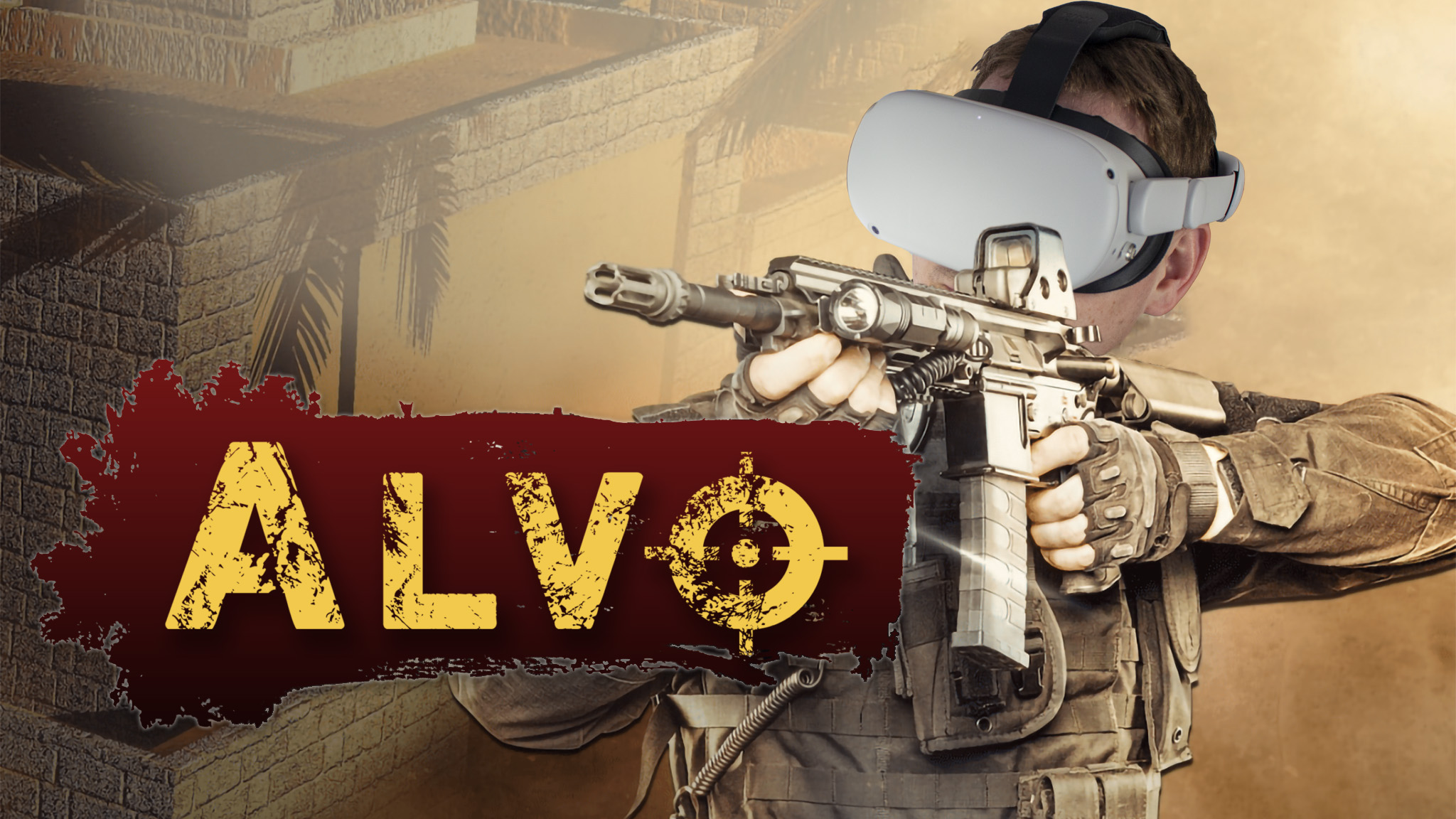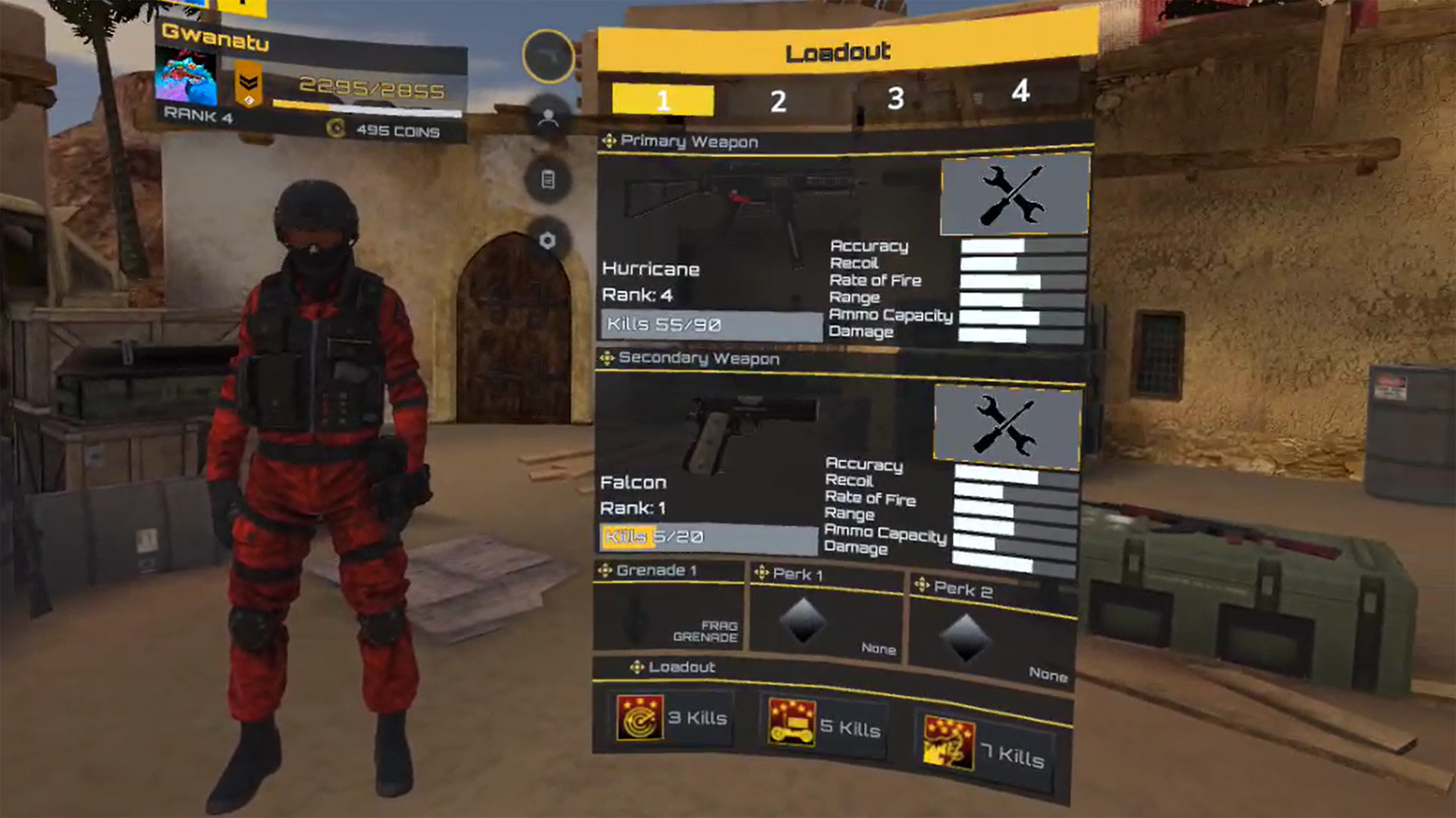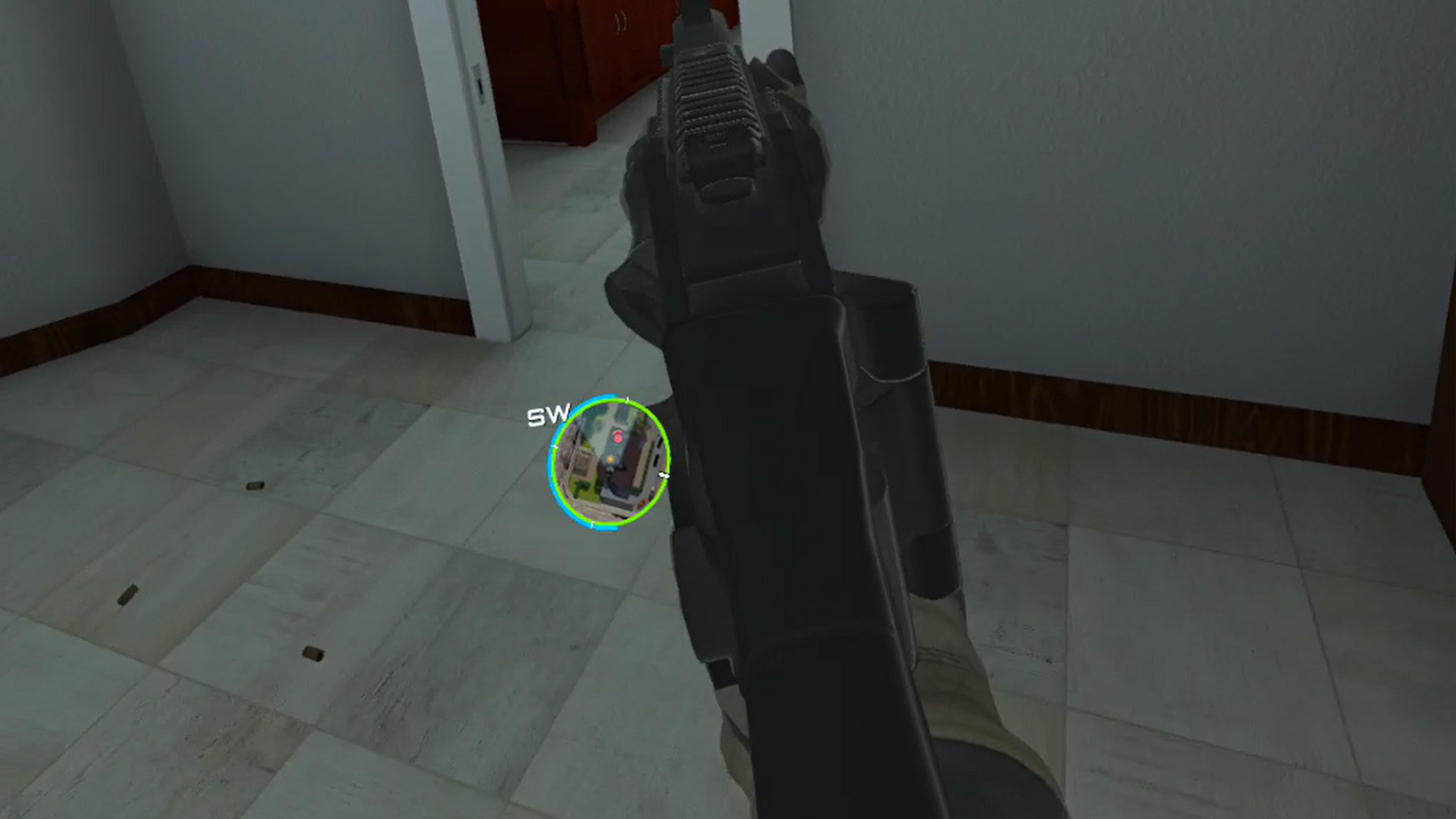Alvo for Quest hands-on: Answering the Call of Duty in VR
Alvo aims to become the new king of the multiplayer shooter hill.

When Alvo first launched on the PSVR around this time last year, its 5v5 gameplay was one of a kind. While there are shooters on the system, there simply aren't that many multiplayer offerings similar to Call of Duty or Counter-Strike. But the situation is very different on the Oculus Quest 2, where players can experience games like Onward, Contractors, and Pavlov.
But while all of these games are in direct competition thematically, Alvo for Quest aims to draw players in who are missing specific Call of Duty-style mechanics and a more robust movement system. I've had the chance to play Alvo for several hours over the past few weeks over a number of beta testing sessions in the lead-up to the game's release on March 17, 2022.
I previously reviewed the game on PSVR when it debuted last year, but the release on the Quest 2 brings about even more fluid movement and gunplay mechanics. I'm not ready to call it one of the best Quest 2 games just yet, but my tune might change when our review lands after the scheduled post-launch patches in the next two weeks.
Swapping realism for pure fun
At its core, Alvo should appeal deeply to Call of Duty fans looking to get their shooter fix in VR. From the get-go, players are encouraged to build out custom loadouts that can be quickly selected before any respawn during a match. But the weapon choices aren’t just predetermined or pre-unlocked guns that players will add to their dream arsenal. They have to be earned.
Players start off with two main loadouts. The first includes a handgun, an SMG, and standard frag grenades. The second is a new dual-wielded pair of Uzis and a smoke grenade. Both loadouts play quite differently and even reload mechanics are different because of the way you hold the guns.
Reloading in Alvo can be a bit jarring at first, depending on which loadout you select. Reloading a standard gun requires players to grab a mag from their left hip which can then be shoved into the gun, triggering a reload animation that takes a predetermined amount of time.
Dual-wielders simply need to point the gun downward to reload in a sort of lightgun game-style.
Dual-wielders simply need to point the gun downward to reload in a sort of lightgun game-style. Think House of the Dead or Time Crisis reload mechanics and you’ll get the idea. It’s a far cry from the highly detailed — and often mostly realistic — reload mechanics of a number of VR shooters.
Get the latest news from Android Central, your trusted companion in the world of Android
Grenade throwing is, similarly, a very different affair when compared to other shooters. Grenades are held on the right hip when you’ve got a normal gun equipped. Reach down to your hip, grab a grenade, and a trajectory line appears from the tip of your gun. You’ll aim with your primary hand and toss the grenade with your secondary hand when the moment is right. It’s odd at first but makes grenade throwing — which is normally a very tricky mechanic in VR — an extremely simple task.
The nice thing here is that you don’t have to precisely grab items like other shooters, which often rely on on-body inventory systems which can become stressful during firefights.
The nice thing here is that you don’t have to precisely grab items like other shooters, which often rely on on-body inventory systems which can become stressful during firefights. Alvo simply wants you to grab a general area of your body — be it the hips or behind your back — and the action of choice simply happens. It’s not realistic but it’s a heck of a lot more fun in a fast-paced environment.
Playing matches will earn you Alvo coins, a currency that can only be earned, not purchased. Better players will find themselves earning currency faster, helping to unlock weapons and add-ons at a quicker pace than other players.
It’s this incentivized earnings system that I’ve really loved about Alvo since its inception. Every other game in this specific niche of multiplayer shooter gives you all the guns right away or provides a super quick path to unlocking them in a single long round. Alvo wants players to keep coming back for days and weeks, providing a way for players to feel proud of the characters they’ve built.
Alvo wants players to keep coming back for days and weeks, providing a way for players to feel proud of the characters they’ve built by spending earned currency on upgrades.
Guns, too, can be customized with a wide range of add-ons and skins. This portion of the game is somewhat similar to After the Fall, in that players will need to use the coins they’ve earned to buy add-ons they feel are worthwhile for each individual gun.
So, too, players will find that their skills during individual matches are rewarded in the form of perks and killstreak rewards that can be chosen from in the loadout menu. I’d love to see a better explanation of what each perk does initially, as the selection icons aren’t always obvious immediately. There are only so many perks, however, so it doesn’t take long to figure it out.
Two perks can be chosen to be always active. Those perks — like a flak jacket that lets you take more bullets before dying, or the revenge perk which drops a grenade in the event of your death — can be extremely helpful for gaining an edge in every round.
Meanwhile, killstreak perks activate upon gaining a 3-kill streak — which will unlock the first perk — 5 kills for the second, and 7 kills unleash that third and final perk for immediate use in the round. The psychological game that perks play on opposing players' minds is very real, too. The moment you hear that drone whirring, the dogs barking, or see that grenade drop on death tells you that there’s a player running around who is a force to be reckoned with.
Alvo’s gameplay is duly fast-paced, as well. There’s no full-body IK modeling here, no physics weight to the guns, and only minor stamina limits on your range of movement. As I noted before, even actions like tossing grenades and reloading your gun have been simplified in order to make the game faster than most other VR shooters available.
Players can run around for a good amount of time before their stamina bar is depleted — a blue circle that wraps around the mini-map that’s pinned to the left side of your gun in the game. It makes stamina easy to see and understand, especially since you’ll likely be looking down at your map often with the radar perk enabled.
Players can also jump around, giving the map a level of verticality that you won’t find in Pavlov. Just keep in mind that jumping reduces stamina in the same way sprinting does.
But my favorite mechanic of all — and one that really helps separate Alvo from the pack — is the ability to slide while sprinting. The feeling of absolute badassery that you’ll get when killing enemies while sliding along the floor is simply unparalleled. If you’re more of a stationary player or a sniper, going prone could mean the difference between getting quickly picked off by enemies and getting kill streaks before anyone finds you.
I also really loved the ability to hear other players while playing the game without using a radio or proximity system. Again, it’s not “realistic,” per se, but it’s a lot more fun to me than trying to wrestle with an on-body two-way radio or getting annoyed when a player 20ft from you can’t hear you.
Speaking of playing well with others, I found it was incredibly easy to join up with other Oculus friends via the built-in Oculus party system. Alvo is the only shooter of its kind that supports this system, and it makes it easy to party up via the Oculus system menu and jump into the game together without any fuss at all. It just works, even if it expects you to stay in the party chat for the best audio experience.
I found it was incredibly easy to join up with other Oculus friends via the built-in Oculus party system.
Visually, Alvo is rather appealing to me. While Contractors is a game that seems to prefer more geometrically-complex environments, the Quest's hardware limitations force that game to settle for some pretty low-resolution textures.
Alvo, on the other hand, goes for the opposite approach. Textures look quite nice, even if you can't tell much from the screenshots here, and models and environment detail are usually good enough to get the job done — with the occasional surprising little detail like cracks in the stucco or vines crawling up a wall to add in a bit of variety.
Similarly, all the maps look visually very different. One takes place in a snow-covered mountaintop monastery, one in what appears to be a war-torn Italian village, another at a tiny chateau complete with a helicopter in the front yard, and the largest map sees players running around an industrial factory filled with neon lights and graffiti. Most maps have a choice of night or daytime lighting scheme, too, helping further up the appearance of visual diversity.
Post launch updates
While Alvo released on Quest on March 17, I didn’t feel it was quite ready for a full review. During the beta, I played with a pretty small pool of players and, even then, only got to play the free-for-all (FFA) gameplay mode. At launch, players can join in on FFA, Team Death Match, or Search and Destroy modes on just over half a dozen different maps. Alvo’s development team has been developing two major post-launch patches that should better fill out the game’s arsenal of modes and maps, however.
That first patch is coming less than a week after launch and will add in a new map called Factory, some control scheme updates, as well as tweaks and balance changes for Team Death Match and Search and Destroy modes and matchmaking.
The second patch, currently slated for the end of March, includes even more content to play. The Desert map from the PSVR version will make an appearance in both night and day variations, and players will be able to lob around sticky grenades and Molotov cocktails. Lastly, this patch will also add in the coveted co-op Zombies mode which, as you might guess, puts human players on a team in an effort to keep hordes of zombies at bay.
Two post-launch patches should deliver a more complete experience for early adopters.
At launch, the number of maps and modes is a bit anemic, but the $25 price makes it a bit more palatable on Quest than the original $40 PSVR launch price. But Alvo also goes up against a lot more competition on Quest than it ever had on PSVR. Pavlov, a community favorite, is filled to the brim with custom maps and a bevy of game modes. Even if it is a bit janky at times, Pavlov is completely free and quite difficult to argue against.
Contractors, another popular multiplayer shooter on Quest, is only $20 and, again, has a massive selection of custom maps, mods, and an inventory of guns that would make most games blush.
But the core of Alvo’s gameplay mechanics is the game’s strong suit and the content problem can be pretty easily solved over a short period of time. If that were to be solved over the following weeks and months, I’d easily choose Alvo over the competition at any time. We’ll just have to see if that happens.









